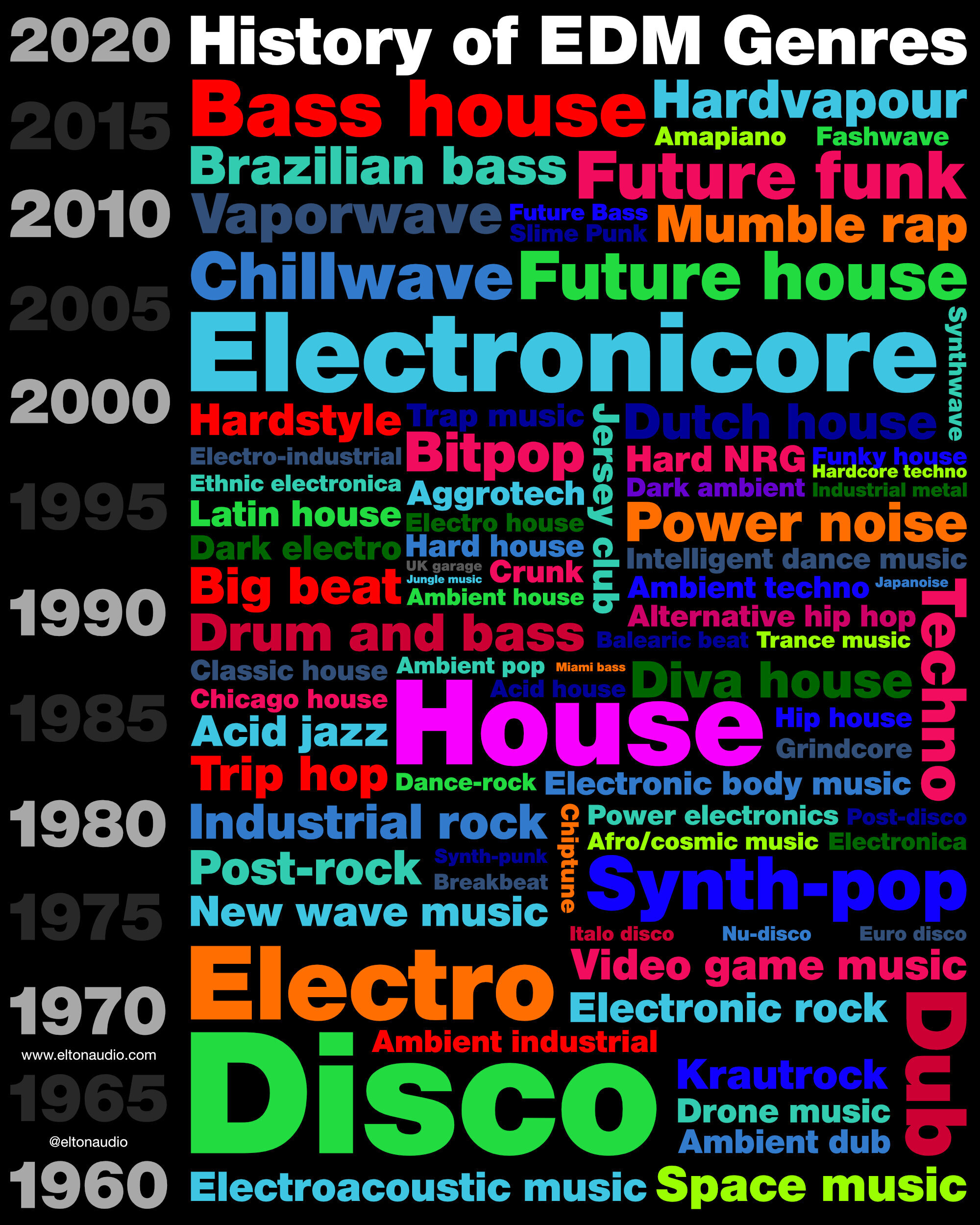The History of EDM Genres
The creation of EDM music is a tribute to how advanced technology has become, specifically music production softwares and hardware. Before the digital age, music could only be made by recording authentic instruments and vocals. However, technological advancements have yielded new inventions such as MIDI input keyboards and synthesizers that allow users to sample and program different sounds, and even create their own sounds using sound wave oscillators. With multiple new synths being created electronically, the industry birthed the genre of electronic dance music.
Electronic Dance Music (EDM) is an expanding genre that continues to grow in popularity as the demand for catchy, upbeat music rises. Many DJ’s favor EDM because it is sure to get their crowd dancing and having a good time, which is why this type of music is most commonly heard at night clubs, or party events and functions. Many pop artists are also incorporating EDM aspects into their music or release official EDM remixes of their original songs, while some music producers even take the time to mash two pop songs together into an EDM track. So the question stands: how did this genre of music become so prominent in the industry?
This is the timeline of how the genre became popularized:
1. 1970’s Disco
The beginning of EDM stemmed from 70’s disco music that was played at dance clubs. Disco music characteristically incorporated many of the elements that are popular in EDM such as synthetic instruments and electronic drum beats to get a crowd moving on the dance floor. The basic “four on the floor” beats (usually a kick drum hitting on the first downbeat of each measure), syncopated bass lines and rhythm guitars kept the tempo up and gave people an easy rhythmic guideline to follow. This use of the drum beats and instruments is called a pocket, in which the rhythm section of the song is locked in and work together as a unit to establish a solid foundation for the melody to follow. Many artists in the 70’s made good use of a pocket rhythm, as they could alter a melody or improvise how they wanted while still staying on tempo.
Disco is commonly set to around 120 beats per minute, which is a relatively standard tempo for dancing as it follows the tempo of our heartbeats. Songs such as “Rock Your Baby” by George McCrae were very popular disco songs that could be heard at clubs throughout the decade. They introduced the use of electronically programmed instruments to the music scene and became the root of future electronic music genres. Thus, establishing synthetic pop as its own subgenre for dance music and paving the way for EDM in the future.
2. Electro Music of the 80’s
The 80’s was considered the post-disco era of the music industry and developed upon the synth pop genre that became more prominent as electronic music softwares became more sophisticated. The European music industry made electronic dance music more mainstream as technology advanced; synthesizers and drum beats were used more frequently, and different innovations such as MIDI (Musical Instrument Digital Interface) made it easier for electronic instruments to communicate through the computer system. These electronic synths were very commonly used in many popular 80’s songs such as “Take on Me” by a-ha and “Don’t You Forget About Me” which was featured in the hit movie The Breakfast Club.
As technology progressed, the equipment required to produce EDM became more accessible and transferrable. Rather than having giant synthesizers that could take up the whole space of a room, these synthetic instruments could easily be inputted to the computer using a small physical interface such as a MIDI input keyboard, that allowed producers to play in the rhythms and melodies that they needed for the song, rather than having to individually program each note. It became easier to utilize these sounds in different musical compositions, and many producers were more inclined to produce EDM because of the high demand for upbeat music during that era.
3. 90’s EDM
The 90’s birthed many of the subgenres of EDM that lovers of the genre would recognize today. House, techno, hardstyle, dub, drum and bass, and trance were all developed as subgenres that propelled EDM into the mainstream music industry specifically in Europe. Each genre has very distinctive sounds -for example, trance music is defined to have a slower tempo around 100 to 115 bpm, with longer melodic phrases that alternate between dissonance (a clashing of harmonies that creates tension) and consonance (a resolution of the tones to a nicely blended chord), however, hardstyle electro music is characterized by an overdriven kick drum and very fast paced tempos- yet they all fall under the synthetic/electronic music genre that many DJ’s liked to use in their setlists.
The night club and rave scene grew in popularity and became the main source of consumption for both popular and underground EDM records. In the United States, Detroit introduced “Detroit techno” which included Mayday’s song “Strings of Life'' which maintains its reputation as a defining record in the techno music genre. 90’s EDM had a lot of hip hop influence, incorporating syncopated beats (also known as breakbeats). Syncopated beats put more emphasis on the unaccented or “upbeats” of a rhythm which give the song a more “bouncy” feeling that is utilized in songs such as “Can’t Touch This” by MC Hammer or “No Diggity” by Blackstreet. However, these songs also had a heavy focus on bass frequencies that are commonly emphasized in today’s mainstream electronic dance music.
4. Mainstream EDM
Starting in the 2000’s, EDM entered mainstream music as more of the genre’s elements were incorporated into pop music. Songs such as “Party Rock Anthem” by LMFAO and “Titanium” by David Guetta featuring Sia were defining songs of the decade that utilized many synthetic sounds and electronic drum beats. Producers began creating instrumental dance breaks that are composed solely of synths and beats. The vocal chorus or pre chorus of the song is often used to build up to the big drop, creating tension that makes the EDM portion more dramatic and hit harder for dancers. These intense buildup sections are often accomplished using subtle sound effects that eventually grow and swell in volume and intensity. Most producers like to include a sweep in the background of their tracks to give the listener a feeling of tension building up, while others like to push the kick drum forward to make the tempo feel faster or add more embellishing elements that eventually build up into the drop.
As the years progressed, more EDM producers entered mainstream radio by incorporating pop singers into their hits as well. The Chainsmokers popularized pop EDM with their hit songs “Closer” featuring Halsey and “Don’t Let Me Down” featuring Daya. Marshmello has worked with Khalid and Anne Marie to make the electronic pop songs that his sets are known to have. Today, EDM is a common element in many mainstream songs that can be heard on the radio, at nightclubs, or at big venues for special events.
From a middle school dance to a nightclub in New York City, electronic dance music can be heard anywhere. With such a high demand for upbeat music that can get people dancing, it is no surprise that EDM has become such a prominent genre that multiple popular artists are trying to incorporate it into their music. This high demand came from the technological advancements that have made EDM equipment more accessible. Rather than needing a professional studio, people can create and sample sounds on their laptops and program MIDI with small input keyboards and drum pads. In fact, DJ’s and producers of today can bring their equipment on the road for live sets, and they can remix EDM music in real time.
However, with EDM being very involved with synthesizing sounds and creating complex drum beats, it is not something that one can simply begin producing. With the popularity of music festivals, night clubs, and DJ events continuing to grow, EDM is a genre that has very high consumption rates. Therefore, it is a very valuable and marketable skill for any producer in the industry to navigate the complex process of sampling and generating new sounds. Overall, regardless of whether EDM is your preferred taste in music, this genre has developed over decade in the history of music, and continues to grow in the industry as technology improves to allow for new music to be made.


